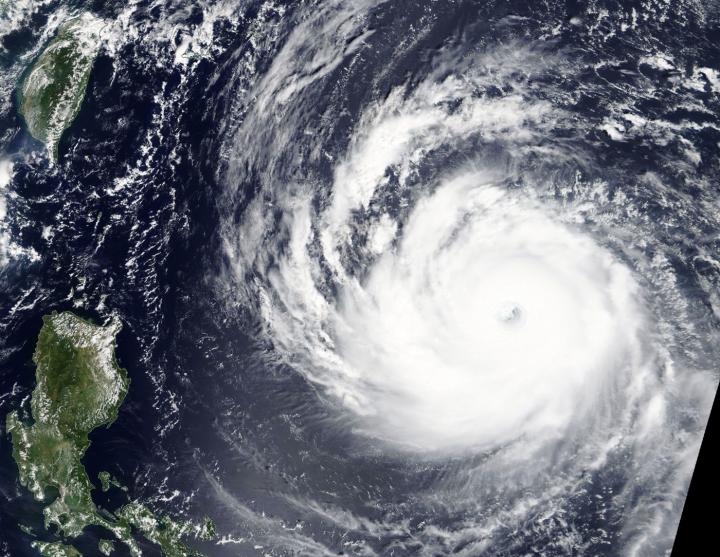NASA's Terra Satellite glares at the 37-mile wide eye of Super Typhoon Trami

At 9:50 a.m. EDT (1350 UTC) on Sept. 24, the MODIS instrument aboard NASA's Terra satellite provided a visible-light image of Super Typhoon Trami in the North Western Pacific Ocean. Credit: NASA Worldview, Earth Observing System Data and Information System (EOSDIS).
At 9:50 a.m. EDT (1350 UTC) on Sept. 24, the Moderate Resolution Imaging Spectroradiometer or MODIS instrument aboard NASA's Terra satellite provided a visible-light image of Super Typhoon Trami in the North Western Pacific Ocean.
The MODIS image showed that Trami has a symmetric eyewall surrounding a 37 nautical-mile round eye.
At 11 a.m. EDT (1500 UTC) on Sept. 24 the center of Super Typhoon Trami was located near latitude 19.4 degrees north and longitude 129.5 degrees east. It is located 445 nautical miles south-southeast of Kadena Air Base, Okinawa Island, Japan.
The Joint Typhoon Warning Center noted that the storm is moving toward the wet-northwest and this general motion is expected to continue. Maximum sustained winds are near 149.6 mph (130 knots/240.8 kph) with higher gusts.
Trami is expected to peak at 167 mph (145 knots/268 kph) in the next day before beginning a weakening trend.
Media Contact
More Information:
https://blogs.nasa.gov/hurricanes/tag/trami-2018/All latest news from the category: Earth Sciences
Earth Sciences (also referred to as Geosciences), which deals with basic issues surrounding our planet, plays a vital role in the area of energy and raw materials supply.
Earth Sciences comprises subjects such as geology, geography, geological informatics, paleontology, mineralogy, petrography, crystallography, geophysics, geodesy, glaciology, cartography, photogrammetry, meteorology and seismology, early-warning systems, earthquake research and polar research.
Newest articles

Webb captures top of iconic horsehead nebula in unprecedented detail
NASA’s James Webb Space Telescope has captured the sharpest infrared images to date of a zoomed-in portion of one of the most distinctive objects in our skies, the Horsehead Nebula….

Cost-effective, high-capacity, and cyclable lithium-ion battery cathodes
Charge-recharge cycling of lithium-superrich iron oxide, a cost-effective and high-capacity cathode for new-generation lithium-ion batteries, can be greatly improved by doping with readily available mineral elements. The energy capacity and…

Novel genetic plant regeneration approach
…without the application of phytohormones. Researchers develop a novel plant regeneration approach by modulating the expression of genes that control plant cell differentiation. For ages now, plants have been the…





















